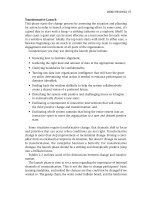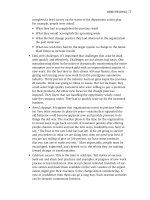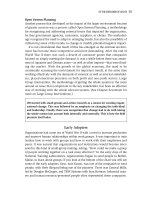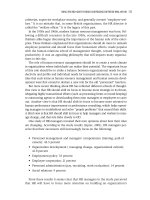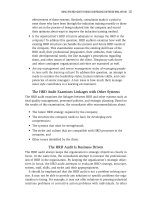Practicing Organization Development (A guide for Consultants) - Part 42 pdf
Bạn đang xem bản rút gọn của tài liệu. Xem và tải ngay bản đầy đủ của tài liệu tại đây (197.44 KB, 10 trang )
• Reacting with courage, grace, and honesty in conflict situations;
• Being self-correcting; and
• Responding when they have control—or don’t have control.
Obviously, the adaptive skills are deeper in the causal chain of human behav-
ior. In fact, it might be more accurate to view what lies in this domain as uncon-
scious automatic tendencies, rather than as skills. The adaptive area explains
why a person does what he or she does in the functional and work content
areas. These characteristics are more about who a person is than what he or
she thinks or does. Most adaptive tendencies are so embedded in people’s psy-
ches that they may not be aware of when they are using them. They may think
they are just being themselves. People who knew a person well when they were
younger could watch him or her at work now and see the child they once knew.
People don’t normally think about the adaptive area—but think from it. For-
tunately, rather than being on automatic, or leaving to chance whether or not
what they are doing is right for the situation, they can become aware of their
adaptive tendencies and begin to exercise some choice in how they respond to
certain situations.
It is a rule of work life that people get hired for their work content and func-
tional skills—or how good they are above the waterline—and fired (or pro-
moted) for their adaptive tendencies—or how good or poor they are below the
waterline. The most effective people at work are those who are willing to try
things and explore, through training, mentoring, or coaching, what is going on
in their adaptive area. OD consultants aspiring to include personal development
interventions in their practice would be well-served to get involved in ongoing
work in their own adaptive area. (See www.scherercenter.com for information
about a personal development approach, You ARE the Intervention, based on
this concept.)
THE INTERPERSONAL BENEFITS OF PERSONAL DEVELOPMENT
1
Identifying and addressing personal development opportunities in an OD effort
has benefits not only for the client(s) being worked with directly, but for all
those the client(s) interact with as well. After all, most accomplishments in the
workplace occur within a relationship infrastructure, a human system, within
which employees, managers, and leaders enter into an ongoing series of inter-
personal encounters.
“If you want to awaken all of humanity, then awaken all of yourself. Truly,
the greatest gift you have to give is that of your own self-transformation.” This
may sound like advice from a current business best-seller. Actually, it comes
PERSON-CENTERED OD INTERVENTIONS 381
22_962384 ch15.qxd 2/3/05 12:23 AM Page 381
from the brilliant mind of Lao Tsu, 6th Century B.C. philosopher (quoted in
Novak, 1994). Stephen Covey (1989), a more recent philosopher, says, “Private
victories must precede public victories.” They both understand the direct and
unavoidable connection between mastering the outer world and mastering your
own inner world. To have earned the right to attempt to influence others, OD
consultants need to be “doing their own work” of self-development. Then it is
appropriate and possible to assist in the development of clients. OD consultants
who attempt to change others without addressing their own development will
be experienced as manipulators.
At the very bottom of self-mastery is mastering fear. Working with a client’s
fear is often a huge factor in the success of any OD effort—fear of the unknown,
fear of change, fear of failure, fear of looking bad. There are a million fears that
grip people in the workplace. Marshall Goldsmith (2000), one of the better-
known executive coaches, asserts that when clients become afraid and highly
stressed, they lose access to their own humanity and become survival-oriented.
This leads to de-humanizing those they are afraid of, stripping them of their
humanity, reifying them, turning them—and themselves—into objects. The
result: a failed relationship between two human beings, failed because at least
one of them has forgotten that everyone involved is a human being. Only
human beings are capable of creative problem solving.
THREE PERSON-CENTERED INTERVENTIONS IN OD:
TRAINING, MENTORING, AND COACHING
We offer a deeper look at the three personal development modalities: training,
mentoring, and coaching, all of which can be used to foster any or all three
areas of personal development as shown in Scherer’s pyramid. We begin with
the most widely used OD intervention to have an impact on personal develop-
ment—training. Even though the work content area (that is, technical) is the
focus of most training, a masterful OD practitioner can also direct development
of functional and adaptive capabilities.
Training: Using a T-Group
One of the oldest person-centered OD interventions, and still one of the most
powerful, is the T-group, which was developed virtually by accident by Lewin
himself.
2
The purpose of a T-group is to provide participants with intense per-
sonal experiences designed to help them examine their ways of interacting
with others, their styles of self-presentation, their basic life positions, their val-
ues, and other issues. Participants work in small groups of eight to twelve people
for periods ranging from three days to two weeks. In OD’s early years, T-groups
382 PRACTICING ORGANIZATION DEVELOPMENT, 2ND EDITION
22_962384 ch15.qxd 2/3/05 12:23 AM Page 382
were a widely used technology for team building and were aimed primarily at
changing attitudes and values. Practitioners and OD pioneers like Bob Tannenbaum
soon realized, however, that one of the unintended consequences of the T-group
was a powerful personal development experience for participants—and facili-
tators.
Adopted and exported to the West Coast in the early 1950s by personal growth
facilitators like Jack Gibb (1978), Will Schutz, and Carl Rogers (1980), the T-
group quickly became the technology of choice for people looking for a devel-
opmental breakthrough. In the process, the T-group eventually was offered to the
public at large, rather than remaining just a means of OD intervention, thereby
divorcing it from its original organizational context. (NTL-LABS [www.ntl.org]
is the organization that has maintained and passed on the T-group, offering
Human Interaction Laboratories around the world.)
In the hands of a well-trained facilitator, the T-group is a powerful, although
somewhat risky, person-centered OD intervention. In terms of individual devel-
opment for the workplace, it can help people, as Geoff Bellman says, to bring
more of who they are to what they do.
Why a T-Group Works in OD
The first thing a T-group participant finds is that the OD consultant/facilitator
does not actually facilitate—at least not in a way that can readily be seen as
useful by participants (Golembiewski, 1977). Participants must interact with
each other without an agenda and without guidance from their facilitator, other
than for processing observations. Generally, the only agenda is: “We are here
to learn about self and others.” The facilitator states a few norms of group
behavior—such as speaking for yourself, listening, practicing authenticity, stay-
ing in the present, and respecting others—then only monitors and comments
on what he or she sees happening. This creates an ambiguous situation for the
group, which must develop of itself. How each participant responds to this
absence of structure reveals a great deal—about each person, about groups,
and about human nature in general. The T-group’s discussion centers on the
present moment, and there is no authoritarian hierarchy since the OD consul-
tant refuses to be drawn into that role. Each participant is afforded equal oppor-
tunities to experiment with new behaviors in an open, trusting climate that
evolves after several days of intensive work. The end result is a shift in how
participants view themselves and others. This shift goes deep because what is
affected is the adaptive level, the person’s core belief system—not conscious
thoughts, but rather those embedded childhood assumptions about self, oth-
ers, and life. A psychological shift takes place at the deepest level, and partic-
ipants find themselves behaving differently in functional skill areas as well
(Scherer, 1980).
PERSON-CENTERED OD INTERVENTIONS 383
22_962384 ch15.qxd 2/3/05 12:23 AM Page 383
Cognitive Dissonance and T-Groups
As Lynton and Pareek (1990) have shown, one reason the T-group works to
change participants’ attitudes and behaviors is the result of cognitive dissonance.
Cognitive dissonance exists wherever there is a perceived difference between what
is and a key belief about what should be happening. It has been said, “Cognitive
dissonance is what happens inside you when you see your worst enemy drive off
a cliff in your new car.” Because of the absence of traditional emotional and con-
ceptual supports, participants are confronted with several kinds of dissonance or
internal discord, which must be reduced. This dissonance manifests in four ways:
1. Between the participants’ expectations of the consultant/facilitator and
the consultant’s actual behavior. Consultants avoid all participant
attempts to seduce, force, or otherwise get them to conform to their
expectations to provide more familiar structure or facilitation.
2. Between a participant’s self-concept and his or her actual laboratory
behavior.
3. Between the participants’ expectations of the group’s reactions to what
happens and the group’s actual reactions.
4. Between the image that a participant wishes to project and the image
that others in fact perceive.
Dissonance between beliefs and reality leads to a discomfort that is often felt
by T-group participants as a kind of chaos, which becomes an uncomfortable
void that they must fill with their own created reality. This act prompts learning
to occur. But then, according to Scherer (1981), chaos is the birth canal for all
personal development. Something has to give. The participant either has to dis-
believe what he or she is experiencing or let go of a belief or assumption about
what he or she thinks should be the case. This dissonance makes the T-group an
intense and disturbing experience, which is exactly why T-groups produce such
high rates of learning retention. Research findings from the U.S. Bureau of
Research place T-group retention rates at 75 percent, compared to 55 percent for
visual material, and 35 percent for lecture presentation (Lynton & Pareek, 1990).
The key point to remember here is that, whether a consultant is designing a
training program or setting up a coaching or mentoring relationship and wants
deep learning to occur, one proven approach is to make sure that there is cog-
nitive dissonance in the experience. The consultant or facilitator must find a
way to confront participants with whatever gaps are present between their con-
cept of things and reality (for example, how trusted others perceive things). This
requires that both participants and the OD consultant be highly skilled at offer-
ing and receiving feedback.
384 PRACTICING ORGANIZATION DEVELOPMENT, 2ND EDITION
22_962384 ch15.qxd 2/3/05 12:23 AM Page 384
T-Group Limitations
T-groups do have their limitations, however:
• You can’t lead others where you haven’t been yourself;
• Not every organization is ready for T-groups;
• T-groups seem to work best with a minimum of eight and a maximum of
twelve participants—which raises the cost-effectiveness question, espe-
cially in large systems;
• An effective T-group requires at least three days’ duration; and
• T-groups conducted with people from the same organization engender a
heightened, perceived—and, in some cases, actual—personal and orga-
nizational risk for participants. For example, “I let Tracy see me in a
more vulnerable and real way today in my T-group, and she’s going to
be sitting across from me in the staff meeting next Monday. What will
happen then?”
As indicated above (Lynton & Pareek, 1990), people who have been to T-
groups on their own have been able to retain and apply a surprising amount of
learning on their return to the organization, regardless of the lack of larger system
involvement.
3
Even with these caveats, the T-group deserves to be understood
and respected, and its principles applied in person-centered OD interventions
because it has great power to shift the attitudes and behaviors of individuals in
an organizational setting.
Personal Development Principles Derived from the T-Group
Regardless of the type of personal development intervention you may be plan-
ning, you would be well-served to consider the following principles that char-
acterize a good T-group:
1. Invite participants to come up with their own learning objectives.
2. Create a design that allows participants to discover things, rather than
telling or showing them.
3. Make the environment a safe place to be, but also a place where par-
ticipants know they will be confronted with their developmental areas.
4. As trainer or facilitator, minimize your role as much as possible, only
providing what the participant(s) can’t provide themselves.
5. Create a supportive climate, where defensiveness is reduced and sup-
portiveness is enhanced.
PERSON-CENTERED OD INTERVENTIONS 385
22_962384 ch15.qxd 2/3/05 12:23 AM Page 385
Jack Gibb (1978) describes two types of group climates this way:
Defensive Climates Supportive Climates
Evaluation Description
Controlling Visioning
Strategy Spontaneity
Neutrality Empathy
Superiority Equality
Certainty Provisionalism
Mentoring and Coaching: One-on-One Personal Development
While training in all its various forms continues to be the delivery system of
choice for most person-centered OD work, a rapidly growing number of indi-
viduals and organizations are turning to one-on-one approaches to save time and
money—and to achieve maximum depth of insight and transformation. One-on-
one developmental relationships have had a long history, dating back to Biblical
times, as when Moses turned to his father-in-law, Jethro, for help (see Exodus
18: 13–27). Although we don’t know exactly what happened in this one-on-one
encounter, here is a possible updated scenario of this Biblical conversation:
“I can’t handle it any more!” Moses says to his trusted father-in-law.
“What’s the problem?” Jethro asks.
Says Moses, “I’ve just got too many people coming to me for decisions and
advice. All day long . . . It’s all I do now. It’s driving me crazy! What can I do?”
Jethro replies, “Well . . . How about this? What if you set up some of your
best decision-makers to be responsible for a hundred people, and a few of
your very best to be responsible for a thousand people . . . that way, some
handle all the little stuff, others handle the not-so-little stuff, leaving you to
take care of the really big stuff . . ”
“Hey!” says Moses. “I like that!” and he did what the two of them had cre-
ated together.
There is a lot about mentoring and coaching embedded in this hypothetical
exchange.
• Moses is hard-working—you might say even driven—and is experienc-
ing some strong dissonance between his idea of how this wilderness trip
was supposed to go and what was actually happening.
• Jethro is older, more experienced, knows his way around, and is some-
one Moses respects. They had sufficient bandwidth for this conversation.
386 PRACTICING ORGANIZATION DEVELOPMENT, 2ND EDITION
22_962384 ch15.qxd 2/3/05 12:23 AM Page 386
• Apparently Jethro had confronted a situation like this before—or at least
Moses believed Jethro had the emotional distance and clarity to see a
new solution.
• Trapped inside his old paradigm—the one that came out of his promise
to Yahweh about getting everyone to the Promised Land all by himself—
Moses couldn’t see his way to a solution for his current distress.
• Moses asked for help. The feedback and coaching were requested. This
opened Moses’ heart and mind to receive Jethro’s idea.
• Jethro first affirmed what would not change in the situation. He is rooted
in reality, not in pie-in-the-sky positive thinking. “Yes, Moses, these peo-
ple are going to keep coming to you—or someone—for a long time.”
• Jethro then suggests something for Moses’ consideration. He doesn’t try
to force or sell his idea. It is a suggestion, not a command. When a good
coach or mentor offers an idea, he does not use positional power with
the client (if he has any), but rather relies on the power of the idea itself.
• Moses acted on his father-in-law’s coaching. He set up the organization
suggested by Jethro and saw it through.
Mentoring
The word “mentor” comes from the name of the Greek man, Mentor, in whose
care Odysseus left his son Telemachus while on his ten-year return voyage from
the Trojan War, as told by Homer in the epic The Odyssey. In Odysseus’ absence,
Mentor not only helped the boy become a competent young man but also saved
his life. This relationship, in which an older or more experienced person assists
a younger or less experienced individual in his or her development, is a model
for what we now know as mentoring. Mentoring has become a widespread
means of providing personal development in OD.
Today’s organizations realize that mentoring programs are quite effective for
addressing such issues as diversity, developing current and future leaders,
retaining high performers, and reducing the time and financial cost of train-
ing/learning. Levinson, Darrow, Klein, Levinson, and McKee (1978) were instru-
mental in defining the mentoring process. Their concept of a mentor includes
such roles as teacher, sponsor, counselor, host, guide, exemplar, developer of
skills and intellect, and supporter.
Mentoring integrates characteristics of parent-child and peer-support rela-
tionships. According to Levinson et al. (1978), young people who do not have
mentors during their formative years are disadvantaged in terms of their psy-
chological and career development. Young people often search for and discover
appropriate mentors on their own, but enlightened organizational leaders are
paying more attention to mentoring and making it an official part of the lead-
ership and management developmental process. Young managers with high
PERSON-CENTERED OD INTERVENTIONS 387
22_962384 ch15.qxd 2/3/05 12:23 AM Page 387
potential are often the first to be given mentoring experiences. Generally, a
young manager is assigned to a mentor who is senior in position and age and
who sometimes occupies a position that is several hierarchical levels above that
of the protégé. Mentors are not necessarily selected from their protégés’ depart-
ments but are selected for their interest, availability, and mentoring competence.
This would include the image of their competence and empathy among col-
leagues, and their ability to provide appropriate emotional support. One men-
tor should not have more than five protégés, say Levinson et al.
Research supports the perceived value of a good mentoring program. The
American Society for Training and Development reported that 75 percent of
executives surveyed cited mentoring as being one of the key factors in their
business success. Business Finance magazine reported that 77 percent of com-
panies credited mentoring with increased employee retention and performance
(see ).
What a World-Class Mentoring Program Looks Like
In the typical workplace mentoring program, a relatively new manager or
employee is invited to take on the role of protégé and seek out someone in the
organization he or she admires who is more experienced and could be a men-
tor. Mentors help their protégés navigate the organization’s culture, including
its political, operational, technical, and even interpersonal dimensions. They
also listen to their protégés’ personal and job concerns, help them search for
solutions to on-the-job problems, share their own experiences, respond to their
protégés’ emotional needs, without creating inappropriate dependency, and cul-
tivate longlasting, informal personal relationships. Here is a short list of what
mentors do with and for their protégés:
• Increase the protégés’ personal and interpersonal effectiveness by pro-
viding feedback about their behavior on the job and assistance in ana-
lyzing their interpersonal competence;
• Review the protégés’ progress in achieving work objectives, especially
project management;
• Identify concerns in and around the protégés that are hindering their
progress;
• Assist in generating alternatives and a final action plan for dealing with
identified concerns;
• Model the best behavioral norms;
• Champion the protégés for special projects, paving the way for their
advancement;
• Assist the protégés in setting goals for continual improvement;
388 PRACTICING ORGANIZATION DEVELOPMENT, 2ND EDITION
22_962384 ch15.qxd 2/3/05 12:23 AM Page 388
• Protect the protégés from the unseen consequences of potentially threat-
ening political turmoil;
• Provide support to the protégé while he or she implements action plans;
and
• Do whatever they can to help the protégé realize his or her potential.
Generally speaking, the mentor focuses on the protégé’s career and move-
ment up and through the organization. In the best mentor-protégé relationships,
however, personal development becomes the emphasis, as the mentor offers
feedback not only in the above-the-waterline aspects of career and job perfor-
mance, but also below the waterline, to address functional and even adaptive
skill areas as well. This requires a mentor who is trained in coaching, and a rela-
tionship with sufficient bandwidth to support the deeper work.
The Risks of Going Deep in Mentoring
Ironically, the deeper the personal development goes in a mentoring relation-
ship, the more risky it becomes. Above-the-waterline conversations are safer
for both parties. Neither really wants the protégé to reveal too much that
might shake the mentor’s confidence in him or her. This results in a certain
limitation on the relationship, usually unconsciously, which restricts what can
and cannot be discussed. If the protégé reveals too many vulnerabilities—cru-
cial to development at the adaptive level, for instance, where the deepest
learning takes place—it might affect the mentor’s support and sponsorship.
The typical mentor, who must also think about his or her own reputation in
the organization, wants to be seen as backing winners. These factors, which
are at work in many mentoring relationships, tend to invite the need for some-
thing deeper, freer, where the protégé can let it go, confident that nothing
shared will come back to haunt him or her later. This deeper work, necessary
for many professionals at various points in their careers, is what coaching is
all about.
This also explains why below-the-waterline coaching is best provided by
someone who is not in the protégé system.
Coaching
“Coaching is an ongoing professional relationship that helps people produce
extraordinary results in their lives, careers, businesses, or organizations”
(www.coachfederation.org). In the words of workplace coach and co-author,
Lynn Brinkerhoff, “Simply put, coaching is a relationship designed to assist the
client in bringing out the best they have in them and applying it in their lives.”
Through the process of coaching, clients deepen their learning, improve their
performance, and enhance their quality of life. In each meeting or phone call—
PERSON-CENTERED OD INTERVENTIONS 389
22_962384 ch15.qxd 2/3/05 12:23 AM Page 389
many clients and coaches never meet each other face-to-face—the client deter-
mines the focus of conversation while the coach listens and contributes obser-
vations and questions. This kind of interaction leads to greater clarity and moves
the client into action. Coaching is intended to accelerate the client’s progress by
providing greater focus, awareness, and increased options. Coaching concen-
trates on where the clients are now and what they are willing to do to get where
they want to be in the future.
There are two basic paths to personal development coaching, corresponding
to the two Medieval spiritual development methods: the via negativa (the neg-
ative road) and the via positiva (the positive road). Both work. The via nega-
tiva is what would be called gap analysis today. The client is assisted in looking
deeply at where he or she is now, where he or she wants to be at some point,
what is standing in the way, and what steps would get him or her where
desired. The via positiva view looks at where things are working already and
how the client can enhance or build on that existing capacity.
The via negativa view focuses on what is missing or not working; the via
positiva view uses what is present when the person or situation is at its best.
Both approaches work—and work equally well. Johnson (1992) would say
that what we have here is a polarity to be managed, not a good thing to be
supported (the positive approach) and a bad thing to be invalidated (the gap-
analysis approach). There are times when a masterful coach will want to have
access to both.
We start with the via negativa, since it has been around the OD consulting
field the longest and is still the path most intuitively taken. Lewin’s Force-Field
Analysis showed that, if you pushed on “driving forces” in a change project,
what usually happens is that the “restraining forces” simply increased to match
our pressure. Lewin asserted that we will get more movement ultimately by
reducing (or reversing) a restraining force, something most of us have experi-
enced first-hand. This success in change efforts has led OD people to focus on
the restraining force side of the equation, analyzing and addressing what is
going against the change. What follows is a gap-analysis coaching process that
has been used to coach individuals in a variety of organizational settings
(Scherer, 1986).
STRIPES: A Breakthrough Coaching Process
These seven coaching dimensions, using the acronym STRIPES, can be
addressed in order during a coaching session. Even better, a consultant could
simply listen to the client, taking notes in the appropriate area, noticing which
areas are receiving the most attention. Eventually, they will see which dimen-
sions need to be explored further to promote the client’s breakthrough. The
dimensions are described below:
390 PRACTICING ORGANIZATION DEVELOPMENT, 2ND EDITION
22_962384 ch15.qxd 2/3/05 12:23 AM Page 390





